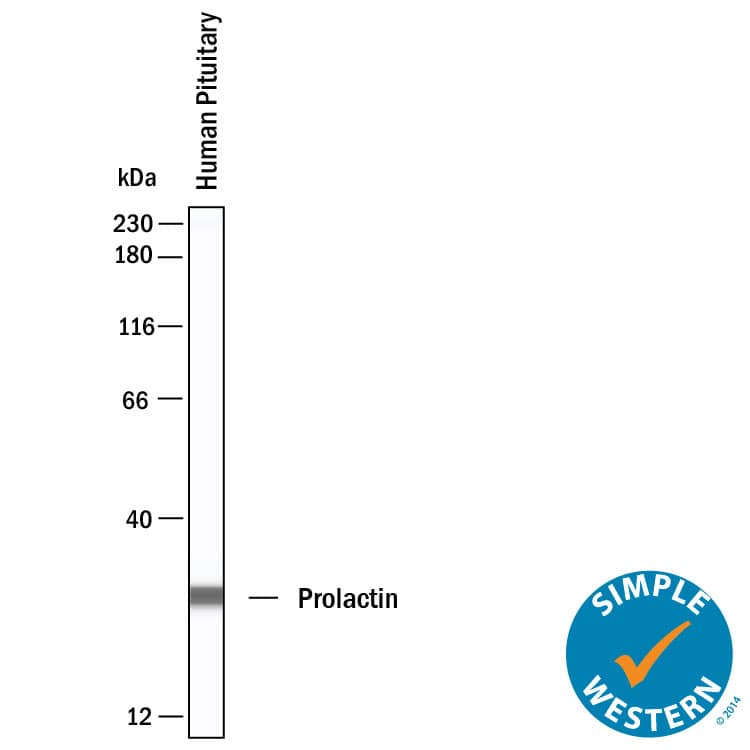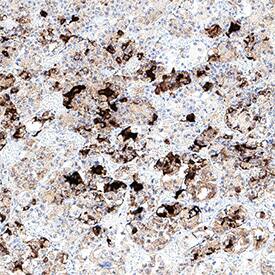Human Prolactin Antibody
R&D Systems, part of Bio-Techne | Catalog # MAB11590

Key Product Details
Species Reactivity
Applications
Label
Antibody Source
Product Specifications
Immunogen
Leu29-Cys227
Accession # P01236
Specificity
Clonality
Host
Isotype
Scientific Data Images for Human Prolactin Antibody
Detection of Human Prolactin by Western Blot.
Western Blot shows lysates of human pituitary tissue. PVDF membrane was probed with 0.5 µg/ml of Mouse Anti-Human Prolactin Monoclonal Antibody (Catalog # MAB11590) followed by HRP-conjugated Anti-Mouse IgG Secondary Antibody (Catalog # HAF018). A specific band was detected for Prolactin at approximately 24 kDa (as indicated). This experiment was conducted under reducing conditions and using Western Blot Buffer Group 1.Detection of Human Prolactin by Simple WesternTM.
Simple Western shows lysates of human pituitary tissue, loaded at 0.2 mg/ml. A specific band was detected for Prolactin at approximately 29 kDa (as indicated) using 20 µg/mL of Mouse Anti-Human Prolactin Monoclonal Antibody (Catalog # MAB11590). This experiment was conducted under reducing conditions and using the 12-230 kDa separation system.Detection of Prolactin in Human Pituitary.
Prolactin was detected in immersion fixed paraffin-embedded sections of human pituitary using Mouse Anti-Human Prolactin Monoclonal Antibody (Catalog # mab11590) at 5 µg/ml for 1 hour at room temperature followed by incubation with the Anti-Mouse IgG VisUCyte™ HRP Polymer Antibody (Catalog # VC001). Before incubation with the primary antibody, tissue was subjected to heat-induced epitope retrieval using VisUCyte Antigen Retrieval Reagent-Basic (Catalog # VCTS021). Tissue was stained using DAB (brown) and counterstained with hematoxylin (blue). Specific staining was localized to the cytoplasm. View our protocol for IHC Staining with VisUCyte HRP Polymer Detection Reagents.Applications for Human Prolactin Antibody
Immunohistochemistry
Sample: Immersion fixed paraffin-embedded sections of human pituitary
Simple Western
Sample: Human pituitary tissue
Western Blot
Sample: Human pituitary tissue
Formulation, Preparation, and Storage
Purification
Reconstitution
Formulation
Shipping
Stability & Storage
- 12 months from date of receipt, -20 to -70 °C as supplied.
- 1 month, 2 to 8 °C under sterile conditions after reconstitution.
- 6 months, -20 to -70 °C under sterile conditions after reconstitution.
Background: Prolactin
Prolactin (gene name PRL) is a secreted neuroendocrine pituitary hormone that acts primarily on the mammary gland to promote lactation, but has pleiotropic effects in both males and females (1-6). Prolactin is predominantly found as 199 amino acid, 25 kDa glycosylated and 23 kDa non-glycosylated monomers (6). Human prolactin shares only 60% and 63% amino acid sequence identity with mouse and rat prolactin, respectively, although rat prolactin can activate the human prolactin receptor (3). Post-translational modifications such as polymerization, complex formation with IgG (in humans), glycosylation, and proteolytic cleavage can alter the activities of prolactin (6-8). Non-glycosylated prolactin is produced by the pituitary and packaged in storage granules before secretion, while glycosylated prolactin is reported to be constitutively secreted, have lower biological potency, and be removed from the circulation more quickly (3, 6, 7). Cleavage by matrix metalloproteinases or Cathepsin D can produce N-terminal 16 kDa antiangiogenic fragments also called vasoinhibins (9, 10). Thrombin can produce C-terminal 16 kDa fragments that are not antiangiogenic (3). Prolactin is synthesized mainly by the anterior pituitary in all mammals, where secretion is under tonic inhibition by hypothalamic dopamine (2, 3). In humans, prolactin is also produced peripherally (2-5). Prolactin expression is low during early human pregnancy, but increases in late pregnancy (2, 3). The prolactin receptor (gene name PRLR) is a transmembrane type I glycoprotein that belongs to the cytokine hematopoietic receptor family. Expression of the prolactin receptor is widespread (2-5). Each prolactin molecule is thought to bind two receptor molecules (11). In addition to its lactogenic activity, peripherally produced prolactin plays roles in breast and prostate cancer development, regulation of reproductive function, and immunoregulation (5, 6).
References
- Cooke, N.E. et al. (1981) J. Biol. Chem. 256:4007.
- Grattan, D.R. and I.C. Kokay (2008) J. Neuroendocrinol. 20:752.
- Ben-Jonathan, N. et al. (2008) Endocr. Rev. 29:1.
- Bernichtein, S. et al. (2010) J. Endocrinol. 206:1.
- Goffin, V. et al. (2011) Nat. Rev. Urology 8:597.
- Price, A.E. et al. (1995) Endoc. 136:4827.
- Hoffmann, T. et al. (1993) J. Endoc. Invest. 16:807.
- Cole, E. et al. (1991) Endoc. 129:2639.
- Piwnica, D. et al. (2006) Mol. Endocrinol. 20:3263.
- Macotela, Y. et al. (2006) J. Cell Sci. 119:1790.
- Broutin, I. et al. (2010) J. Biol. Chem. 285:8422.
Alternate Names
Gene Symbol
UniProt
Additional Prolactin Products
Product Documents for Human Prolactin Antibody
Product Specific Notices for Human Prolactin Antibody
For research use only


